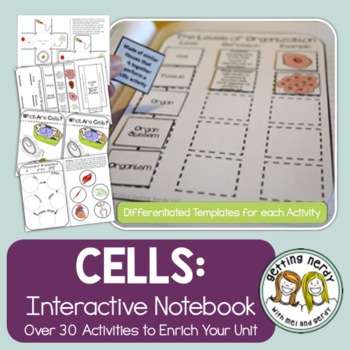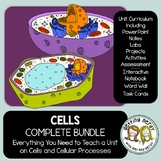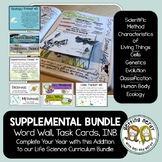Cells Science Interactive Notebook Activities
- Zip
- Google Apps™

What educators are saying
Also included in
- Engage your students with over 200 Interactive Notebook activities in digital google and regular format for all of your life science needs. Our interactive notebook flippers will have your kids "flipping" their way to learning all about cells, genetics, evolution and more! Use these activities as stPrice $95.95Original Price $113.60Save $17.65
- Unit Lesson Plans complete with guiding PowerPoint and student pages? ✓Word walls? ✓ Interactive Notebooks? ✓Task Cards? ✓You're ready to teach with this comprehensive bundle for teaching Cells and Cellular processes. Engage your students with our animated PowerPoints and aligned lessons, 30+ InteraPrice $99.95Original Price $126.85Save $26.90
- Word walls? ✓ Interactive Notebooks? ✓Task Cards? ✓You're ready to teach with this comprehensive bundle to supplement your life science curriculum. Engage your students with over 200 Interactive Notebook activities, a year-long visual word wall with roots, suffixes and prefixes AND English and SpaniPrice $169.95Original Price $218.25Save $48.30
Description
Engage your students with over 30 Cells Organelles and Processes Interactive Notebook activities for all of your cell unit needs. Our interactive notebook cut and paste flippers and online digital slides activities will have your kids "flipping" their way to learning all about cell organelles and cell processes. Use these activities as stand-alone lessons or as a supplement to our Cells Unit Bundle. Disseminate these lessons as you see fit through creating a PowerPoint, in a class discussion or as small group activities. The possibilities are endless!
WHAT'S INCLUDED IN THIS LESSON:
• 180+ pages (30+ activities) of NON-EDITABLE activities in PDF format and directions and a link to our AMAZING Digital format for use in Google Classroom and with directions to convert into Microsoft Schools. This bundle covers the following topics:
→ Characteristics and needs of living things
→ History of cell discovery, Robert Hooke and microscopes
→ Cell type comparison: plant versus animal, eukaryotic versus prokaryotic
→ Cellular transport: endocytosis, exocytosis, diffusion, osmosis, active and passive transport
→ Cellular respiration and photosynthesis
→ Cell reproduction
• Directions and link for digital version
• Directions for each activity
• Color and backline versions where possible
• Answer keys within the PDF
• Examples of each activity within the PDF
• Absent student pre-filled activity sheets within the PDF
STUDENTS WILL:
• Cut out, fill in and color the templates
• Move diagrams, type in text boxes in digital version
• Complete each activity individually, in pairs or in groups
THIS PRODUCT IS ALSO FOUND IN OUR:
• Life Science Interactive Notebook Bundle
• Life Science Interactive Notebook Complete Bundle
CHECK OUT OUR OTHER INTERACTIVE NOTEBOOK LESSONS:
• Lab Report Templates for Interactive Notebook
• Genetics - Interactive Notebook
• Evolution - Interactive Notebook
• Human Body Systems - Interactive Notebook
• Classification - Interactive Notebook
• Ecosystems and Ecology Interactive Notebook
• End of Year Interactive Notebook Activities
SEE HOW THIS LESSON ALIGNS WITH THE NGSS, TEKS or GSE
TERMS OF USE (TOU):
All rights reserved by GETTING NERDY®️
• This product is to be used by the original purchaser only
• Intended for classroom and personal use only
• Copying for more than one teacher, classroom, department, school, or school system is prohibited
• This product may not be distributed or displayed digitally for public view
Failure to comply is a copyright infringement and a violation of the Digital Millennium Copyright Act (DMCA). Clipart and elements found in this PDF are copyrighted and cannot be extracted and used outside of this file without permission or license.
Interactive Notebook: Cells and Cell Processes © 2012 to present Getting Nerdy ®️ All Rights Reserved
www.gettingnerdyscience.com








